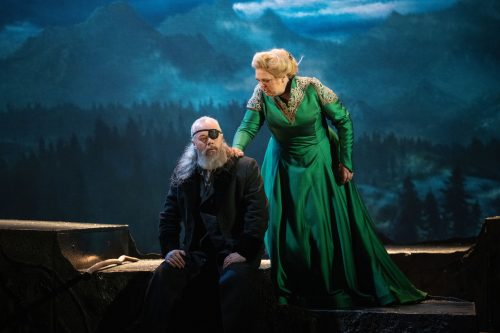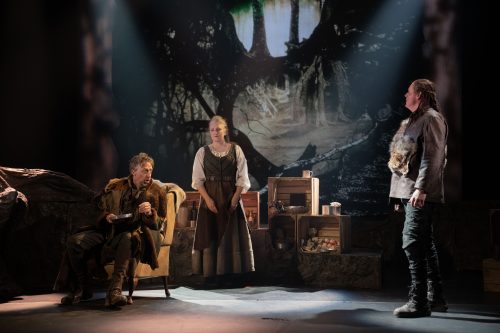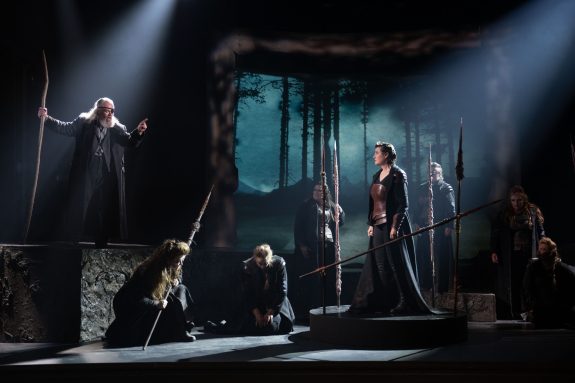 United Kingdom Longborough Festival Opera [3] – Wagner, Die Walküre: Soloists, Long borough Festival Orchestra / Anthony Negus (conductor). Recorded at Loughborough (directed by Matthew Dilley) on 26.6.2024 and available on OperaVision and YouTube until 9.2.2025. (JPr)
United Kingdom Longborough Festival Opera [3] – Wagner, Die Walküre: Soloists, Long borough Festival Orchestra / Anthony Negus (conductor). Recorded at Loughborough (directed by Matthew Dilley) on 26.6.2024 and available on OperaVision and YouTube until 9.2.2025. (JPr)

I completed a Ring cycle, of sorts, in 2023 with Amy Lane’s staging of Götterdämmerung (review here). It had all begun with Das Rheingold in 2019 but was interrupted by the pandemic meaning that the planned three full cycles were delayed until this year when they took place over successive weeks. This was the third Ring cycle in the relatively short history of Longborough Festival Opera and that is astonishing in itself. In 2021 there was still social distancing, though Longborough went ahead with putting on Amy Lane’s Die Walküre with a restricted audience (the theatre only holds 500 anyway), an even more reduced orchestra of 30 and singers avoiding each other at all costs on the small stage. I did not go to see the Ring this season but caught up with the full Die Walküre Lane intended for the cycle thanks to the recording of the performance on 26th June and now freely available to see and hear.
Watching it, one of the first words that comes to mind is intimacy, there are no novelties to the filming and it is as though the performance was taking place in someone’s front room, albeit a large one. I suppose that is what this converted – and now very well upholstered barn in Gloucestershire – actually is. The overall impression of what I saw was that – in the main (and with notable exceptions) – what Lane give us is something so straightforward and traditional that it would have been seen very many times before in the opera’s 150 years. There were no winged helmets or any chariot drawn by rams for Fricka but there were spears; furs and animal skins (for Siegmund and Hagen); a hearth and the stump of a tree with a sword so visible in it that it didn’t need the extra illumination it gets a one point; and, amongst much else, Wotan has a patch covering his left eye.
The overall look seems sepia-tinged at times with Emma Ryott’s dark costumes being aided and abetted by Tim Baxter’s video projected at the back of the stage making it all look as if we had wandered into the illustrations of Arthur Rackham or the paintings of Casper David Friedrich. Baxter created considerable atmosphere with his gloomy forests, scudding threatening clouds, foaming waters, sunrises and sunsets, images of the moon, starscapes, wooded mountain valleys (with vistas glimpsing a fortress-like Valhalla), as well as the all-important flames for the final scene. Notably impressive were the thundering horses’ hooves for the Valkyries and Wotan. Harking back to 2021, the orchestra is now 60 (still on the small side for Walküre) and the singers still seemed to be ‘avoiding each other at all costs on the small stage’ often singing towards each other from opposite sides of it. Rhiannon Newman Brown’s set seemed basically some shallow steps to either side rising to a low platform across the back and in the last two acts a small central dais. It was black and looked as it was supposed to give the appearance of basalt rock.
The best acting in opera is reacting and the close-up camerawork often allows us to appreciate the work of a cast of consummate singer-actors and there was some impressive storytelling. Of course, I was listening to a recording through loudspeakers, but their diction was so impeccable it was possible to follow almost every word of the libretto and the singer-friendly accompaniment from Anthony Negus and his Longborough Festival Orchestra helped. The reduced Walküre orchestration was by Alfons Abbass and had a chamber-like intimacy at times though seemed to give full-value to the ‘Ride of the Valkyries’ and ‘Wotan’s Farewell’ when the orchestra sounded as good as I have ever heard it. As before after a measured start Negus’s Walküre was rich in detail and perfectly paced across the three acts. It first allowed passion to bloom for Siegmund and Sieglinde, before he whipped along those Valkyries and ended with some gloriously evocative ‘Magic Fire Music’.
Reviewed as a standalone performance, Amy Lane effectively stages the emotional high and lows of the difficult relationships over the three Walküre acts: there is burgeoning incest (Siegmund and Sieglinde), marital discord (Sieglinde/Hunding and Wotan/Fricka) and the love of a father (Wotan) for the daughter (Brünnhilde) he must abandon. However, certain leitmotifs of her Ring go unexplained or underdeveloped. Firstly, there is Wotan’s enfeeblement as he appears ailing from time to time before pulling himself together (a lack of Freia’s golden apples?). There is also, what looks like, a leather-bound journal (Erda’s earthly wisdom foretelling events?) he brings on at the start of the opera and leaves for Sieglinde. At the end of the first act Sieglinde scribbles the note that she is leaving Hunding on a page from it but takes the book with her. That page seems to reach Fricka at the start of Act II, Sieglinde must drop the book because Wotan has it at the end of that act. There is a lot of covering eyes with hands and Wotan and Brünnhilde have magical powers. At the end of the second act Brünnhilde initially freezes Hunding with her hand just as Wotan does to Siegmund allowing him to get stabbed in the back. It is actually Sieglinde who now collects Siegmund’s broken sword. The hyperactive Valkyries are goth-like and appear to be trying to rein-in invisible horses. The small central dais acts as a ‘dock’ surrounded by spears in which Brünnhilde is put on ‘trial’ before being ‘jailed’ within it by Wotan.
In general, the singing transcends criticism, however, I do wish these Ring cycles had left us with a legacy of young Wagner singers who would go on to sing their roles with increasing regularity in the future. The highlight of Emma Bell’s excellent Sieglinde was the moment she discovers from Brünnhilde that she is carrying Siegmund’s child. Bell sang ‘O hehrstes Wunder! Herrlichste Maid!’ (‘O glorious miracle! O wondrous maid!’) with all the radiance this exultant outburst demands. (At times I wondered how even better this Walküre might have been had Bell sung Brünnhilde.)

The unusual (for Wagner) colours and nuance Marc Le Brocq brought to ‘Ein Schwert verhiess mir der Vater’ (with iron-lunged cries of ‘Wälse! Wälse!’), ‘Winterstürme wichen dem Mond’ and during the ‘Annunciation of Death’ duet in Act II with Brünnhilde showed it is possible to sing a big role like this lyrically (at least in Longborough’s small theatre).
Julian Close’s familiar baleful bass voice was ideal for his imposing, callous and brutal Hunding. As in 2021 there was a masterclass from Madeleine Shaw – again shunning all the black and grey for an elegant emerald gown – as the domineering, resolute Fricka who (again) gave the browbeaten Wotan no chance of winning their domestic argument. The enthusiastic Valkyries were clearly well-coached and sang more evenly than some octets do.
Lee Bisset didn’t really let anyone down as Brünnhilde despite her voice not sounding as fresh or as secure as it once was. Just like 2021, once past her ‘Hojotohos’, acting-wise, her Brünnhilde was very subtly characterised and moved from the feisty innocence of Wotan’s devoted daughter to the broken – though defiant – figure at the end.
Repeating his 2021 Wotan too, Paul Carey Jones’s chief god looked even more grizzled and world-weary and was obviously channelling Sir John Tomlinson’s seminal portrayal of the role. Carey Jones began the Act II scene – when Wotan recounts the Ring story up to that point – very quietly and employed Sprechstimme for what started like a Shakespeare soliloquy. His Wotan soon rallied for all the familiar anger and bravado as he railed against his perceived misfortune even though he appeared to be manifesting ‘Das Ende!’ rather than fearing it.
What another remarkable Longborough Festival Opera achievement, do watch it if you can.
Jim Pritchard
Featured Image: Paul Carey Jones (Wotan), Lee Bisset (Brünnhilde) and Valkyries © Matthew Williams-Ellis
Creatives:
Director – Amy Lane
Set and Props designer – Rhiannon Newman Brown
Costume designer – Emma Ryott
Lighting designer – Charlie Morgan Jones
Video designer – Tim Baxter
Associate Lighting designer – Clancy Flynn
Assistant Director – Leo Doulton
Choreographer – Lorena Randi
Cast:
Siegmund – Mark Le Brocq
Sieglinde – Emma Bell
Wotan – Paul Carey Jones
Fricka – Madeleine Shaw
Brünnhilde – Lee Bisset
Hunding – Julian Close
Gerhilde – Eleanor Dennis
Ortlinde – Cara McHardy
Waltraute – Rebecca Afonwy-Jones
Schwertleite – Verena Gunz
Helmwige – Katie Lowe
Siegrune – Carolyn Dobbin
Grimgerde – Katie Stevenson
Rossweisse – Rozanna Madylus
